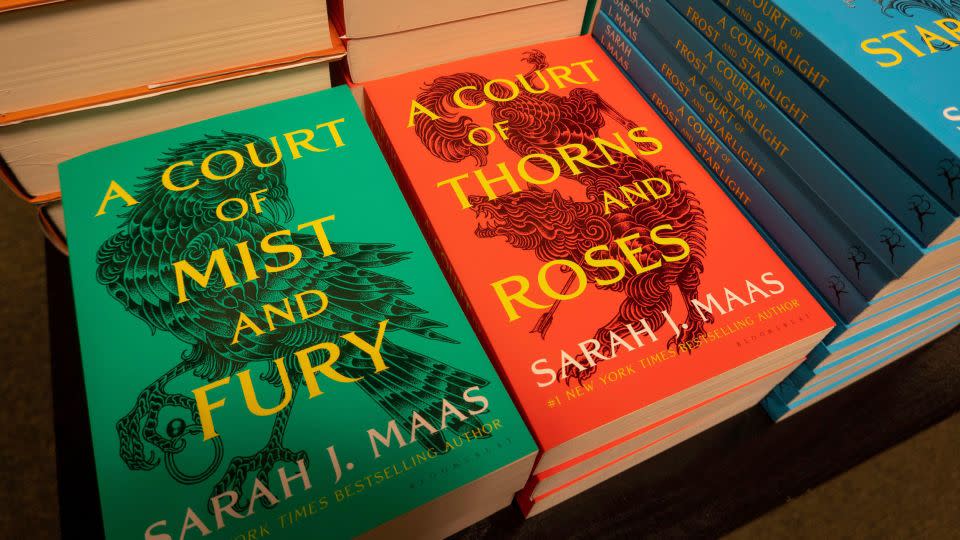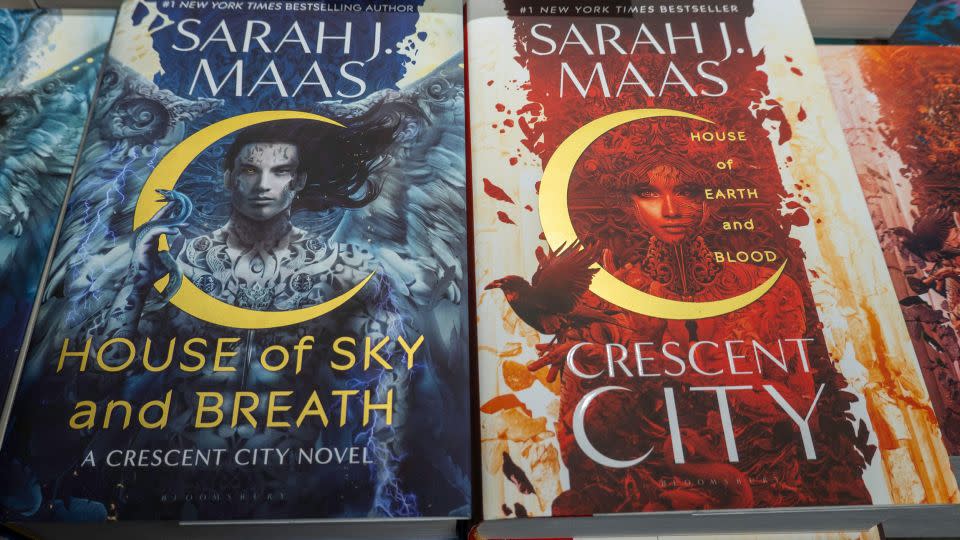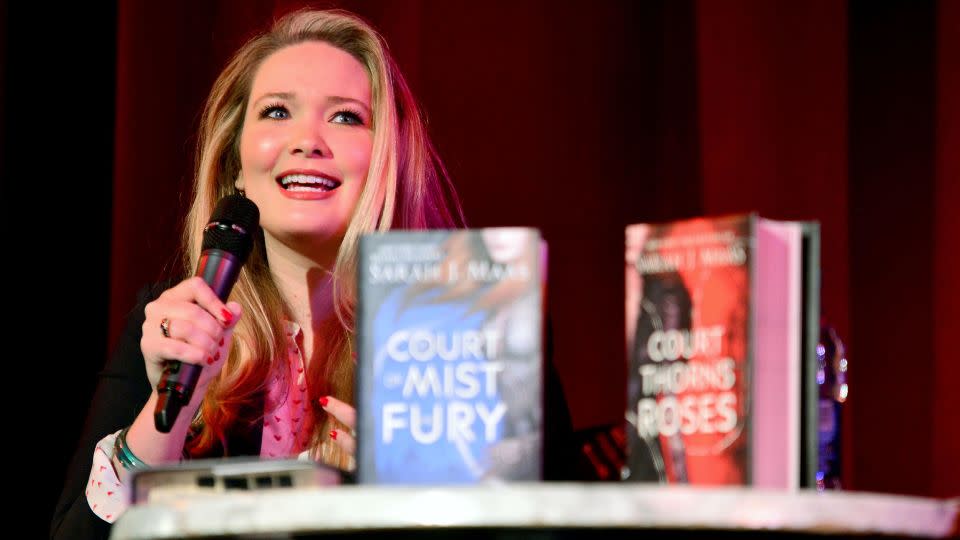Fairies, dragons and steamy sex scenes: ‘Romantasy’ books are the new must-reads
Among contemporary readers, a few genres are reliably popular: Crime thrillers, for one, or twisty mysteries that can be turned into limited TV series, or historical dramas that speak to the current moment.
But when it comes to the literary flavor that’s dominating readers’ attention in 2024, it’s clear: “Romantasy” reigns supreme.
Romantasy has become a popular new term for a familiar subgenre — one that blends the otherworldly escape of high fantasy with the emotional payoff of romance novels, and it’s sweeping millions of readers off their feet. When romantasy protagonists (such as dragon-riders, fairies and fallen angels) aren’t busy saving their worlds, they’re falling deeply in love — often with someone they formerly considered an adversary (the “enemies-to-lovers” trope does big numbers with romantasy readers).
BookTok, TikTok’s hugely influential community of bibliophiles, popularized the term “romantasy” last year while discussing the work of Sarah J. Maas, a prolific writer whose “A Court of Thorns and Roses” (or “ACOTAR”) series has proven especially popular.
Readers are devouring Maas’ work: She has three books on the New York Times’ top 10 combined print and e-book fiction bestseller list. Another popular romantasy novel, Rebecca Yarros’ “Fourth Wing,” has spent 42 weeks on the New York Times’ bestseller list, while its sequel, “Iron Flame,” is in its 15th week.
Romantasy is breaking through among readers who previously didn’t browse the fantasy aisle — and delighting readers who’ve loved it for years. We talk to authors, experts, longtime fans and recent converts about why readers are flocking to romantasy stories, in which treacherous quests are punctuated by steamy trysts.
What is romantasy?

Romantasy is a portmanteau of fantasy and romance, two beloved yet frequently misunderstood genres.
“The romance plot is important and central — but so is the fantasy element,” Frankie Diane Mallis, author of romantasy series “Daughter of the Drowned Empire” and adjunct professor at Arcadia University, told CNN.
In Yarros’ best-selling “Fourth Wing,” for example, protagonist Violet Sorrengail is tasked with surviving a rigorous dragon-riding program at her magical university while a rebellion brews beyond its walls. SPOILER ALERT: That she happens to fall in love with the dashing warrior — whose father was killed by her mother — is just as critical to her development by the book’s end. It’s a treat for patient readers when they consummate their love. (Yarros couldn’t be reached for comment; a representative said she was deep in the writing process of her next book.)
If fantasy literature is epic and spellbinding and romance is wrenching and sensual, then romantasy should be the best of both literary worlds. It’s what bookseller and romantasy fan Gideon Ariel calls “Swiss Army lit” — a subgenre that all readers can enjoy, from longtime fantasy nerds to newcomers.
The hits are all there — meticulous worldbuilding, magic, self-discovery, vanquishing foes — all through a romantic lens that softens the denser high fantasy elements.
“Romantasy strikes a perfect balance between romance and fantasy that makes for a more enjoyable experience for a lot of readers,” said Ariel, a romantasy specialist at A Room of One’s Own, a queer- and trans-owned bookstore in Madison, Wisconsin.
The term’s origins are as murky as the motivations of a romantasy heroine’s mysterious lover. Per the Guardian, Maas’ publisher Bloomsbury claims it invented the portmanteau, but an Urban Dictionary definition for romantasy dates back to 2008. It wasn’t a widely used term among publishers or readers, though, until late 2022 — when the work of Maas and her peers made it to BookTok.
But romantasy really took off in 2023, a phenomenon that’s still propelling fantasy romances to bestseller lists. And on TikTok, romantasy hashtags have appeared in more than 200,000 TikToks that have been collectively viewed more than 800 million times.
Why romantasy is resonating now

Though Maas’ “ACOTAR” novels, the first of which was published in 2015, are still among the most frequently read and recommended romantasy books, her work belongs to a subgenre that’s existed for decades before the term “romantasy” was used to describe it.
Prolific writers like Diana Gabaldon, whose time-traveling historical romance series “Outlander” began in the early 1990s and inspired a popular TV drama of the same name, and Nalini Singh, who’s penned dozens of paranormal romances since the early 2000s, have created millions of fantasy-romance fans across the world. And beginning in 2005, readers couldn’t get enough of Stephanie Meyer’s “Twilight” series, one of the biggest YA hits ever with nearly 160 million copies sold as of 2021.
Mallis credits romantasy’s recent rise to indie publishers: Independent imprints like Entangled Publishing have released some of the subgenre’s major successes, including Yarros’ “Fourth Wing.” And there are successful authors, such as Jennifer L. Armentrout, who started out by self-publishing their work before later books were distributed by major publishing houses.
Until recently, “the genre didn’t have the chance to flourish” because many romantasy authors lacked access to the publishing industry, Mallis said. “We’ve all been hungry for these kinds of books, and now finally have the means to write them freely, and with social media, we can get them directly into the hands of our readers.”
BookTok’s infatuation with romantasy has established it as a major subgenre — and perhaps convinced publishers to take its readers seriously. Many of BookTok’s most popular creators are women, and they’re touting stories often written by women, centering on women’s relationships (even if their partners are orcs, vampires or Greek gods). TikTok is just one arm of a movement by readers and authors to reframe how romance novels and “chick lit” are perceived.

“I’ve always been a fan of fantasy, but romantasy has become a space for women’s imagination and storytelling to come to the forefront,” said Gemma Todd, a BookTok personality who regularly recommends romantasy novels to first-time readers.
During a time when many women feel powerless against forces that seek to steal their agency, it’s no wonder that romantasy has captured readers’ imagination, said Jayashree Kamblé, an English professor at LaGuardia Community College and president of the International Association for the Study of Popular Romance.
“Many romantic fantasy novels give female characters power that reduces female vulnerability and expands choices,” Kamblé said. “So of course we seek creative ways to envision those truths, especially when existing power structures actively want to deny us access to them.”
The transportive effect of fantasy romances has been a lifeline for some readers, Ariel said. Books like “Legends & Lattes,” a “cozy romantasy” story that follows an orc who abandons adventuring to open a coffee shop, have provided him with much-needed escapism during difficult times.
“The combo of fantasy and romance offers some much needed relief from the frankly dystopian-esque times we seem to be living in,” Ariel said.
It can also be comforting to read a story with a reliably happy ending on the horizon: Whether the protagonist and their lover get a happily ever after (“HEA” to regular readers of romance) or wind up happy for now (an “HFN” ending), a good romantasy series almost always ends with someone happily in love, said Beth Gabriel, a librarian in the Milwaukee Public Library system (which also has a sizable TikTok presence, encouraging viewers to read).
“No tragedy in my romantasies, thank you,” she said. “If you tell a romance reader it is a romance, (then) Happily Ever After is a legally binding contract, a promise.”
Relationships in romantasy books often take very steamy turns

Sex scenes appear in many, but not all, romantasy novels. But these aren’t hasty, lightly plotted larks: In many of the most popular romantasy titles, sexual encounters may not show up for hundreds of pages — character building is always paramount.
“I still need the tension, and a reason for these kinds of scenes to be happening,” Mallis said, noting she still loves to read and write these scenes. “Sometimes, when the characters reach this point, the tension fades — but if done well, the tension will shift into something else … The more build-up, the better, I think, to achieve this.”
Fans often rank books’ “spiciness” in fan forums, even creating guides to the chapters and pages across which the trysts unfold so that readers can skip directly to the sex (or so the spice-averse know which pages to avoid).

Sex scenes feature heavily in two current bestsellers: Maas’ “A Court of Flame and Shadow,” the third book in her “Crescent City” series, and Yarros’ “Iron Flame,” a sequel to her hit “Fourth Wing.”
In both books, the sex is vivid, sensual and flowery. Lightning pulses through Maas’ and Yarros’ protagonists mid-coitus, and both authors make creative use of the word “entrance.” Perhaps most importantly to readers, the scenes in both books place an emphasis on female pleasure.
Romantasy is making reading hot again, in more ways than one
Longtime romantasy reader and BookTok star Todd is thrilled that the subgenre is having its “water cooler moment.” Countless readers are connecting with it, sharing live reactions to especially emotional chapters and dissecting details with friends and social media followers.
And romantasy’s popularity is blooming beyond TikTok, too: Hearkening back to the era when “Harry Potter” and “Twilight” books were still being published, bookstores are hosting midnight release parties for new books by Maas and Yarros.

“Having access to these stories and reading them together, if virtually, is fun,” Todd said. “I can then tell my best friends to read it too, and we can share that experience, even if we argue about how much we enjoyed it, or things that made us mad.”
Demand for romantasy is so high that there’s a six-month wait for one of the 48 digital copies of “Fourth Wing” in Wisconsin’s digital consortium, Gabriel said. She’s also had to reorder copies of works by Maas, Yarros and Tracy Deonn, author of the popular YA “Legendborn” series.
“TikTok is definitely driving demand for books at my library branch, and I love that readers are turning to the public library to try some of these trendy titles,” she said.
Ariel, also in Wisconsin, is singing romantasy’s virtues to customers at A Room of One’s Own. But before he discovered the subgenre, he detested reading for school assignments, let alone for pleasure. Now, romantasy is where he turns for renewed hope and escape.
“The genre shows that adventure takes all forms, love can and will find a way, and anything is possible.”
Looking to give romantasy a try? Here are some of the best books to start with, according to our sources.
The hits
“A Court of Thorns and Roses,” Sarah J. Maas (first in the “ACOTAR” series)
“Fourth Wing,” Rebecca Yarros (first in the “Empyrean” series)
Cozy delight
“Legends & Lattes,” Travis Baldree
Gothic romantasy
“The Beautiful Ones,” Silvia Moreno-Garcia
High spice
“A Touch of Darkness,” Scarlett St. Clair (first in the “Hades x Persephone Saga” series)
“From Blood and Ash,” Jennifer L. Armentrout (first in the “Blood & Ash” series)
Low spice
“Divine Rivals,” Rebecca Ross (first in the “Letters of Enchantment” series)
“Legendborn,” Tracy Deonn (first in the “Legendborn Cycle” series)
Slow burns
“Daughter of the Drowned Empire,” Frankie Diane Mallis (first in the “Drowned Empire” series)
“Slave to Sensation,” Nalini Singh (first in the “Psy-Changeling” series)
For more CNN news and newsletters create an account at CNN.com


